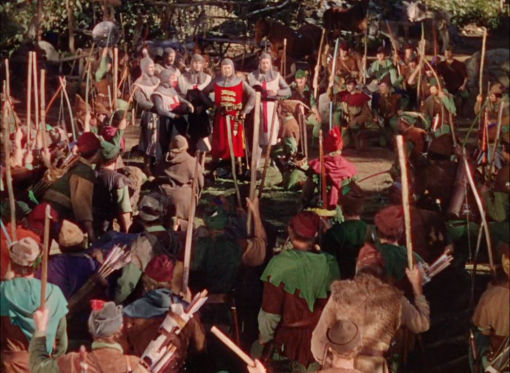Summary of the Gest
The Gest is divided into eight sections, known as Fyttes. Here's a breakdown of the main action for you.
Fytte 1 -- Robin wants to have a guest before they eat. Little John finds a poor knight in threadbare clothing. The knight's son killed someone in a joust and the knight had to borrow 400 pounds from St. Mary's Abbey, York to pay the bail. Now, the loan is due, and the knight doesn't have the money and will lose his lands. Finding him to be honest, Robin loans him the money and gives him fine clothing. He sends Little John along with the knight.
Fytte 2 -- The abbot of St. Mary's and others are eager to seize the knight's land. The knight shows up and pretends to be broke. They show no mercy. And therefore, when the knight pays up he doesn't give them a tip. The knight returns home, collects the money, and makes a gift of fine bows and arrows, to repay Robin. On his way to Barnsdale (Robin's base), he is delayed to help a yeoman in a wrestling match.
Fytte 3 -- Meanwhile, Little John goes to Nottingham and enters an archery contest. The sheriff is impressed and drafts Little John into his service. After spending some months with the sheriff, Little John causes trouble, fights and recruits the sheriff's cook and they make off with the sheriff's treasure. Later, they lure the sheriff into meeting Robin Hood. In exchange for his freedom, the sheriff promises not to harm Robin.
Fytte 4 -- Waiting for the knight to return his loan, Robin and his men intercept the high cellarer of St. Mary's abbey. The monk is rude and dishonest, and so Robin robs him of 800 pounds, claiming the virgin Mary has sent this payment. When the knight does show up, Robin gives him another 400 pounds.
Fytte 5 -- The Sheriff of Nottingham holds an archery contest for a gold and silver arrow. Robin wins the contest. But his men are ambushed, Little John is wounded, and they take refuge at the castle of the knight (now called Sir Richard at the Lee).
Fytte 6 -- The sheriff goes to the king for help, and returns to capture Sir Richard. Sir Richard's wife goes to Robin for help. Robin rescues the knight, kills the sheriff and flees to the forest.
Fytte 7 -- Planning to deal with Robin personally, the king goes to the forest disguised as an abbot. He makes friends with Robin. They have an archery contest which Robin loses. The knight discovers the king's true identity. Robin enters the king's service.
Fytte 8 -- The king and his men disguise themselves as outlaws and go to Nottingham. Robin serves the king for 15 months. Broke and bored, he returns to Barnsdale, reforms the band, and they stay as outlaws for 22 years. Robin is bled by his cruel cousin, the Prioress of Kirklees, and dies. The Gest also implicates the prioress's lover Sir Roger of Doncaster (Donkestere or Donkesly) in Robin's death.




Contact Us